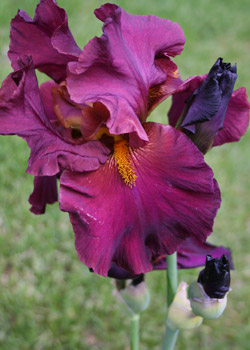Bearded Iris Bulbs Information

Few flowers in the garden are more elegant than bearded iris. Blooming in late spring to early summer, the blooms of a bearded iris look quite stately and eloquent rising above others in the flowerbed. Popular with florists for their long, sturdy, and straight stems, iris fit perfectly in any bouquet. Another great feature of Iris is that they are not favored by deer, squirrels or bunnies.
Plant Information
- Planting Time: Late Summer/Fall
- Bloom Time: Late Spring
- Hardiness Zone: 4-9
- Suitable Zone: 4-10
- Light Needs: Partial - Full Sun
Planting Bearded Iris Rhizomes
- Bearded Iris rhizomes are best when planted in late summer or early autumn. The roots of the iris grow from the bottom of the rhizomes and it is very important that they become established prior to the winter season. Late planted rhizomes may not bloom full strength during the first spring season.
- Iris rhizomes are extremely susceptible to rot and therefore, it is important to be sure the soil is well-drained. Choose an area with this type of soil and receives a full or at least half day of sun.
- Iris rhizomes should be spaced 12-18" apart.
- The rhizomes of the Bearded Iris should be placed just slightly below the surface of the soil, with approximately no more than a ½" of soil covering them. Planting the rhizomes too deeply will only encourage rot.
- Bearded iris rhizomes often have evidence of the prior year's growth on one side. Place the rhizome horizontally to the soil surface with this side facing upward.
- Thoroughly soak the area with water once all the rhizomes have been planted. Roots will form in fall and then the bulb will sprout and bloom in spring. Water as needed while the plant is growing and blooming.
- After the flowers have died, you can remove the flower stem and spent flower blossom all the way to ground level, allowing the rest of the foliage to remain until fall. This is especially important with Reblooming Iris to encourage another cycle of blooms late summer or in autumn.
- In fall, cut back the leaves to 4-5" to prevent insect and disease problems the following season.